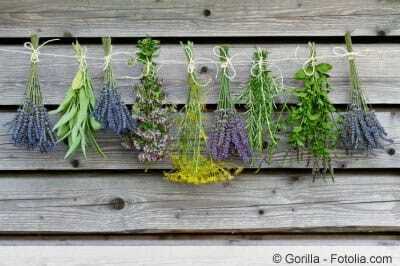

Table of contents
- The right time
- crop cut
- topiary
- maintenance cut
- taper cut
- education cut
- dry
- air dry
- In the oven
- In the dehydrator
- Conclusion
As a classic among spice, medicinal and ornamental plants, rosemary thrives as a semi-shrub. This trait implies that the plant becomes woody in the lower regions, while the herbaceous shoot tips provide the desired herbal harvest and produce a magnificent bloom. In the professional care protocol, the cut thus represents a horticultural challenge. Choosing the right time is just as important as the incision itself. In addition, the clippings need to be stored properly to ensure the best quality. Read here how to cut rosemary and dry it properly.
The right time
There are various occasions when the hobby gardener uses scissors to cut his rosemary bush. The focus is initially on harvesting the aromatic leaves in order to supply the kitchen with them. In addition, the subshrub requires an annual maintenance cut so that it does not bare from the inside. Last but not least, the Mediterranean herbal plant takes on the shape of a decorative tall stem with the help of a targeted cutting technique. In practice, the following dates have proven to be advantageous:
- Harvest pruning for fresh consumption or for drying: From the end of April in the midday hours when the dew has dried
- Topiary: In connection with each crop
- Pruning for maintenance: In late autumn or early spring
- Rejuvenation pruning: preferably at the beginning of budding
- Training pruning: Over the course of the entire growing season
Another pruning motive is the rejuvenation of a neglected rosemary bush to breathe new life into it. If a shape and maintenance cut has been missed for several years, the months of January and February are considered the best time for a rejuvenation cut.
Tip:
If it has rained extensively in the previous days, the date for the cut should be postponed. Both the aroma and the suitability for drying are significantly affected by moisture in rosemary.
crop cut

Not only the evergreen, needle-like leaves promise aromatic pleasure, but also the sky-blue flowers. If you also keep the habitus as a semi-shrub in mind when harvesting rosemary, the measure will be carried out professionally. Ideally, you don't just cut off individual needle leaves, but cut off entire branches to just above the woody area. Please note that rosemary does not sprout from the old wood or only with great difficulty. Therefore, leave 0.5 to 1 cm of the herbaceous part of the shoot on the branch, as new branches with fresh leaves and new flowers will sprout from it. The flowers themselves are not cut, but picked.
Tip:
Only freshly sharpened cutting tools that have been meticulously disinfected with alcohol are used to cut rosemary.
topiary
Since a rosemary bush decorates the balcony and garden at the same time, prudent hobby gardeners combine every harvest with a topiary. How to do it right:
- As part of the harvest, repeatedly take a few steps back to decide how to proceed
- Maintain the natural growth form in a round, oval or columnar silhouette as far as possible
- Cut off shoots that have grown out of shape
The additional effort of a topiary in connection with the harvest is rewarded with a dense, bushy growth and little woodiness. If the herbaceous shoot tips linger too long on the Mediterranean subshrub, they will lignify within a short time and throw off the leaves. With a regular pruning during the year, you can keep this tendency of the herbal plant under control and enjoy the historical spice, medicinal and aromatic plant for many years.
maintenance cut
With floral stubbornness, a rosemary bush strives to lignify as quickly as possible. Since this tendency is at the expense of evergreen leaves and flowers, hobby gardeners are just as vehemently opposed. In addition to the annual harvest and topiary, an annual maintenance cut contributes to this. Here's how to do it:
- Shorten specimens that have overwintered outdoors by at least a third in spring
- Cut off all frozen shoot tips all around
- Cut off all deadwood at the base and thin out thoroughly in this way
In the end, the plant should grow airy and fluffy again, with the sun reaching the lowest regions. If a rosemary moves to a bright, frost-free winter quarters in autumn, the maintenance cut can be carried out beforehand. This makes sense especially when the room is crowded with other winter guests.
taper cut

It quickly happened that a rosemary bush got out of sight of regular garden care. In particular, hardy varieties that thrive in beds are sometimes forgotten and are not consistently cut back. The result is a senile bush that, in the best case, still thrives in the outermost tips with leaves or isolated flowers. However, it would be premature to uproot the plant because there is hope for renewed growth. If the winter has said goodbye with its ground frosts and the new shoot is imminent, bring the bare shrub back on its feet. To do this, cut off all branches up to 10 cm above the ground and fertilize generously with compost and horn shavings. In the period that follows, gardening patience is put to the test, because the plant can take its time until next year with renewed growth.
education cut
Conjure up a decorative tall stem from a rosemary bush, which adorns the balcony and garden with its evergreen foliage and the perennial, wonderfully fragrant flowers. The plan works so easily:
- On a biennial plant, choose the strongest branch for the trunk
- Cut off any side shoots that come off it
- Put the scissors as close as possible to the trunk so that there are no clothes hooks
As the main shoot grows to the desired height, consistently prune any new side shoots and base shoots. Only then do you cut the top, whereupon a lush branching begins here. Determine 3 to 4 main branches, which in turn are animated to branch out by a cut. In this way, you can grow the subshrub into a magnificent standard over the years.
dry
Although rosemary is suitable for the preparation of numerous cold and warm dishes, a lovingly cared for shrub regularly excess clippings - far too good to dispose of on the Compost. How good that the southern aroma artist can be dried so well for a long shelf life. There are several procedures to choose from, which we will explain in more detail below:
air dry

Dry air is a free preservative without any chemical additives. Although it takes some time for the herb branches to dry, hobby gardeners have favored this variant for generations. Tie the cut shoots together into small bouquets with a raffia ribbon and hang them upside down in an airy, not too bright place. Check the tying material from time to time as it will loosen as moisture escapes from the branches. After 2 to 3 weeks the process is complete. Now strip off the aromatic needles to keep them in the dark screw-top jar until you need them.
Tip:
Do not hang rosemary bouquets out to dry in the kitchen. The different food scents falsify the typical herbal aroma in the long run. The attic or a basement room is more suitable.
In the oven
If air drying takes too long, convert the oven into a drying device for herbs. It's that easy:
- Rinse the rosemary sprigs under cold water and pat dry with a paper towel
- Line a baking sheet with parchment paper to spread the sprouts on it
- Preheat the oven to 40-50 degrees in convection mode
- Place the baking sheet in the middle and leave it there for 2 to 3 hours
- Do not close the oven door completely, but stick a wooden spoon or cork in it
Check the herb sprigs repeatedly during the process. When dried properly, they can no longer be bent. Strip the needles from the cooled branches and store them in a light and airtight container.
In the dehydrator
In the private kitchen garden, the purchase of a dehydrator for the preservation of fruit and vegetables proves to be a good idea when the harvest is higher. A dehydrator is also suitable for drying rosemary. Spread the washed and dabbed dry twigs loosely on the sieve trays so that a maximum of 90 percent of the area is covered. Then set the dehydrator to 45 to 50 degrees Celsius. The integrated heater with blower removes moisture from the herbs within a few hours. If the branches lose a brittle consistency, the dehydrator has done its job. As with all other methods, only now pluck or strip off the needle leaves and fill them in a dry, opaque container.
Conclusion
A regular cut is one of the mainstays of professional care of rosemary. Do not cut the evergreen shoots just for the harvest, but give the Mediterranean herbal plant a neat shape at the same time. In addition, thin out the plant thoroughly in spring and cut back all branches by at least a third. If you are confronted with a neglected, senile herb bush, a courageous pruning down to 10 cm will work wonders. As part of the various pruning measures, a supply of rich branches accumulates, which can be dried with simple means. Air-dry rosemary in bunches, spread out on the baking sheet in the oven or conveniently in the dehydrator for a long shelf life.
 garden editorial
garden editorial I write about everything that interests me in my garden.
Find out more about R for Larkspur

Larkspur (Delphinium) - profile and care tips
From a botanical point of view, the petals that are so attractive to us are transformed sepals. Delphinium fans call the center of the flower a bee.

Hardy perennials: 22 perennial bloomers
Hardy perennials as permanent bloomers in the flower bed enchant the garden from early summer to autumn with a colorful bloom. They are easy to care for and magically attract butterflies, bees and the like.

What goes with roses: 30 beautiful rose companions
The beauty of roses really comes into its own when surrounded by the right companion plants. It is important for rose companions that they have similar requirements to roses. We tell you what goes well with roses.

Creating a flower bed: 9 tips for planning & designing
The transformation of a "naked" garden area into a lush sea of flowers doesn't just begin with the planting. Site conditions must first be checked and suitable plants selected. If you want to design a particularly beautiful bed, you can also add a pinch of creativity when laying it out.

Spindle tree (euonymus): care from A to Z
Spindle trees are very popular because of their abundance of flowers. Although they are considered very undemanding, some details should be considered when caring for them.

Unusual Fertilizers | 13 home remedies that can do more
Much of what accumulates in the household and usually ends up in the organic waste bin can be used to fertilize garden and/or indoor plants. They offer an ecological alternative to mineral fertilizers and score with environmental compatibility and sustainability.
